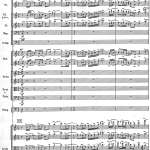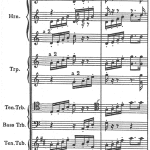Octave doubling will always result in an increase in volume, and is by far the most common type of doubling. Indeed, it would be difficult to imagine an orchestral work without any octave doublings. One such work does exist, however – Arnold Schoenberg’s Variations for Orchestra op. 31 (1928). In his first orchestral work following the formulation of the twelve-tone method, Schoenberg attempted to avoid octave doublings altogether. The background for this was his fear that the octave would threaten the identity of the twelve-tone row, and therefore his earliest dodecaphonic works consistently avoided any combination of the various row transformations that would result in an octave simultaneity. The octave is the first overtone in the overtone series, and is therefore present in almost all instrumental sounds. Presumably, Schoenberg eventually realized that the exclusion of octave doublings would be futile[1].
In figure 30, Mozart makes use of octave doublings to generate more volume, as well as to integrate melody and accompaniment in terms of register. Here, as well as in the Debussy example (figure 31), the octave doubling also creates a denser sound.
Historically, octave doubling is one of the ubiquitous archetypes of orchestral music, its function not only to amplify or clarify the relationship between various elements, but also used as a dramatic tutti effect.
Figure 40 · Shostakovich, Symphony No. 5, 1st movement, m. 247
A special type of octave doubling occurs when a unison line moves through a register spanning several octaves (or even the full orchestral range), making it impossible for any single instrument or group to play the entire passage. This may occur in both directions, from low to high or from high to low, but the former is by far the most frequent. Very often, single instruments will be seen to change “lanes,” i.e. jumping up or down an octave in order to be able to continue playing. Here once again it is important that such shifts do not occur simultaneously in several instruments, but smoothly and carefully graduated (see the orchestrated crescendos in the examples by Berg and Berlioz, figure 13 and figure 15). Countless examples exist with a wealth of different features.
Figure 41 · Holst, The Planets, “Jupiter,” m. 266
Other doublings than octaves may be used to render a line that moves through a wide register seem continuous and unbroken. Attention may be drawn here to the fascinating phenomenon of “infinite glissando,” an auditory illusion in which a tone seems to continually ascend or descend in pitch (referred to as a Shepard-Risset glissando after the American psychologist Roger Shepard and the French composer Jean-Claude Risset). This rise or fall in pitch is actually a “perfect” electronic version of the line that continuously moves through many orchestral registers. It can be realized in the studio, in the case of the ascending line by continually and imperceptibly adding very low frequencies that increase in volume, while the highest frequencies gradually disappear out of the hearing range.
· · ·
Next · Parallel Doubling (Chapter 4. Unisono and Doubling)
· · ·
[1]As used here, the term “overtone” refers to the octave as the first overtone above the fundamental. If the term partial – preferred by some – is used, the fundamental is counted as the first partial, the octave as the second.

